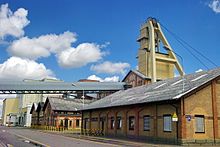Bad Friedrichshall salt mine
The Bad Friedrichshall salt mine is a salt and show mine in the Baden-Württemberg city of Bad Friedrichshall .
location
The Bad Friedrichshall salt mine is located in the south of the city of Bad Friedrichshall , in the salt mine industrial area . In the immediate vicinity of the salt mine are the Bad Friedrichshall-Kochendorf train station and the Bad Friedrichshall Süd junction with Bundesstraße 27 .
history
Today's Bad Friedrichshall salt mine is the second salt mine in the history of Bad Friedrichshall.
After rock salt was drilled in what is now Bad Friedrichshall-Jagstfeld in 1816 and a boiling house with a preheating and boiling pan, a brine storage tank and a drying room had been built, production began in 1818.
1854-1859 the successful drilling of a shaft for mining salt mining . However, the mine collapsed in 1895 and was flooded. Today the Schachtsee exists on the site of the former shaft.
In 1896 the shaft in what is now Bad Friedrichshall-Kochendorf was sunk as a second salt mine. It was named King Wilhelm II and was put into operation in 1899.
In 1944 a concentration camp was set up in Bad Friedrichshall , the Kochendorf concentration camp , whose prisoners were supposed to set up an armaments factory in the Bad Friedrichshall salt mine.
In 1984 the rock salt mines Heilbronn and Bad Friedrichshall were connected underground. The König Wilhelm II shaft was renovated between 1986 and 1988 and equipped with a new conveyor system.
In 2012 the newly designed and modernly designed visitor mine in Bad Friedrichshall was reopened.
Visitor mine
Along with Merkers (Thuringia) and Berchtesgaden (Bavaria), the Bad Friedrichshall visitor mine is one of three visitor mines in Germany and the only one in Baden-Württemberg dedicated to salt mining.
Visitors can experience 200 million years of geological history in it. For example, you can experience the glittering world of crystals that have grown over millions of years in the so-called crystal hall .
The domed hall of the salt mine has monumental reliefs as well as a 42-meter-long slide with an elevation difference of eleven meters. In the technical chamber you can see real conveyor belts and loading vehicles; salt mining then and now is explained. In addition, the visitor receives information there about the formation, geology, history, mining and use of rock salt.
In addition to the historical, the Bad Friedrichshall salt mine also presents the present and innovation in salt mining, especially the work of the high-tech machine Continuous Miner . The work of this machine is shown in the high-tech chamber .
Bad Friedrichshall concentration camp memorial
The armaments industry came to Bad Friedrichshall in January 1944. The salt mine was to be expanded into a bomb-proof armaments factory. In September 1944, the first prisoners came to the concentration camp near the salt mine and Bad Friedrichshall-Kochendorf train station , the Kochendorf concentration camp (a satellite camp of the Natzweiler-Struthof concentration camp ). More than 200 forced laborers died in seven months and prisoners who were no longer fit for action were transported to Vaihingen and Dachau . At the end of March 1945 the concentration camp in Bad Friedrichshall was evacuated.
Today a permanent exhibition in the Bad Friedrichshall salt mine commemorates the forced labor of the prisoners in the concentration camp. Fifty years after the end of the war, the city of Bad Friedrichshall had a memorial stone erected on the site of the former camp. In 1999 the Miklos Klein Foundation was established by the city of Bad Friedrichshall. She is the sponsor of the exhibition in the salt mine and was named after the Jew Miklos Klein who was hanged in the Kochendorf concentration camp. The forecourt of the Bad Friedrichshall-Kochendorf train station was also renamed Miklos-Klein-Platz after him.
The exhibition is located 180 meters below the surface in a dismantled salt hall. Here the prisoners produced aircraft turbines, among other things.
The memorial is integrated into the tour of the visitor mine.
The Miklos Klein Foundation, formerly the Kochendorf (Bad Friedrichshall) concentration camp, is a founding member of the Association of Memorials in the former Natzweiler concentration camp complex .
Individual evidence
- ^ Report of the city of Bad Friedrichshall on the reopening May 1st, 2012
- ↑ https://stadtarchiv.heilbronn.de/fileadmin/daten/stadtarchiv/online-publikationen/23-schatzkammer_salzbergwerk.pdf Stadtarchiv Heilbronn
- ↑ Archived copy ( memento of the original from September 18, 2016 in the Internet Archive ) Info: The archive link was inserted automatically and has not yet been checked. Please check the original and archive link according to the instructions and then remove this notice. Memorial sites in Baden-Württemberg
- ↑ Concentration camp memorials establish network of remembrance. December 22, 2018, accessed December 23, 2018 .
Coordinates: 49 ° 13 ′ 9.5 ″ N , 9 ° 12 ′ 34.7 ″ E

